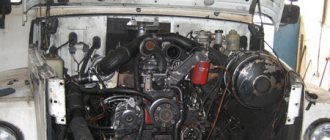The legendary Soviet truck GAZ 53 was produced by the Gorky Automobile Plant for more than 30 years. During this time, more than 4 million trucks rolled off the assembly line. The car has proven itself on the good side - affordable and easy to repair, inexpensive to maintain, the LAWN always came to the rescue when it was necessary to transport cargo. Often the car was loaded more than normal, but it dutifully carried any luggage.
Dump truck based on GAZ 53
There is just one circumstance that upset car owners - quite high fuel consumption.
GAZ 53 in detail about fuel consumption
Many of us can hardly imagine our life without a car, and some cannot even live a day without it, but every family has some restrictions on the use of a car, one of which is the GAZ 53 fuel consumption per 100 km, which is steadily increasing in price every day . Moreover, Soviet cars are not distinguished by their economical consumption of gasoline, not to mention truck models.
GAZ 53 is a widespread truck, the largest and most spacious in the USSR. The production of this car began more than 50 years ago,
and before the closure of this brand of trucks in 1997, it saw several improvements and was produced in more than 5 modifications.
| Model | Consumption (highway) | Consumption (city) | Consumption (mixed cycle) |
| GAZ 53 | 25 l/100 km | 35 l/100 km | 30 l/100 km |
Various factors affecting consumption
You cannot expect from a car that the average fuel consumption of a GAZ 53 per 100 will be exactly what is indicated in official documents. A positive change is quite expected, because it is rare when a car has to move on an empty highway, a flat road, optimally loaded, etc.
Such factors affect fuel consumption
:
- machine load level;
- outside temperature (engine warming up);
- driver's driving style;
- mileage;
- air filter;
- technical condition of the engine;
- carburetor condition;
- tire pressure;
- brake condition;
- fuel quality.
Fuel consumption GAZ 53
The high fuel consumption of the GAZ 53 is due to some features. Firstly, this is due to the fact that the model was invented in Soviet times, therefore, like many cars of that period, it could not be economical. Secondly, almost all trucks, to one degree or another, consume a significant amount of fuel.
Gasoline consumption GAZ 53 per 100 km
According to official data, the GAZ 53 gasoline consumption standards were 24 liters per 100 km. This calculation was made for mixed use, when part of the movement occurred along the highway, and part - in an urban environment.
Fuel consumption GAZ 53 diesel
The manufacturer did not provide for the installation of engines that consume diesel fuel on the dump truck. However, some modifications of the truck had engines that ran on gas. At the same time, gas installations made it possible to develop power up to 105 horses. At the same time, according to official data, consumption was 32.5, and in winter – 37.75.
In reality, fuel costs may not coincide with data from official sources. According to the technical characteristics of the GAZ 53, fuel consumption can be 24 liters if the car is maintained in excellent condition, is not loaded at full capacity and moves at average speed. Many factors influence the level of fuel consumption in a GAZ 53 truck.
There is a certain list of criteria that influence this indicator. These are the characteristics of the GAZ 53, at which fuel consumption increases. It becomes larger, depending on the wear of the brake system and engine, the condition of the air filter and carburetor. Mileage and driving style have a particular impact on fuel consumption.
Improvement of technical condition and repair
What fuel consumption is on GAZ depends on the state of repair of the GAZ 53 car. If you begin to notice that gasoline is being consumed too actively, this may be an alarming sign indicating that there may be problems under the hood of the car, perhaps even very dangerous ones.
The reason that your GAZ 53 fuel consumption is too high may be the following problems
:
- filter clogging
; one way to save on gasoline consumption is to replace the air filter, but first you can take it out and check if it is clogged; - carburetor condition
; You can try to wash this car device yourself; It is also recommended to tighten the screws if they are loose; - cylinder performance
; one or more cylinders in the GAZ 53 engine may not work, due to which others have more load, and, consequently, fuel consumption increases; - It is also necessary to check whether all cables are correctly connected to the cylinders; if there are problems with the connection, this may cause increased fuel consumption;
- breakdowns in the ignition system
; this part of the machine design may cause the motor to operate with interference due to overheating; as practice shows, the switch is a very common problem on the GAZ 53; - low tire pressure
; Fuel consumption directly depends on this factor; If increased tire pressure can help save money, but vice versa, under-inflated tires will cause unnecessary expenses.
Owner reviews about consumption
Alesey, 28 years old, Omsk
I inherited my half-century GAZ from my grandfather, so I know the car inside and out. In summer it takes about 35 liters per hundred square meters, in winter it can be up to 45. It all depends on the load on the body and driving style.
Vitaly, 56 years old, Kemerovo
I am a professional driver, familiar with GAZ. My car consumes no more than 30 liters, while my comrades consume up to 45 per 100 km. It all depends on the maintenance of the machine - I look after my wet nurse, which is why she eats so little.
Oleg, 32 years old, Podolsk
I worked in a car service center for a long time, then moved into trucking. I chose GAZ 53 because it is the only truck in which you can independently reduce consumption. I changed the engine, adjusted the carburetor, so my GAZ car consumes only 23 liters per 100 km.
Pavel, 19 years old, Kostroma
My father and I organize apartment and office moves. We chose a GAZ 53 for work, but were disappointed in the car. It consumes a lot of fuel - up to 50 liters per hundred square meters.
Proven ways to save
Unfortunately, today gasoline is not as cheap as in the Soviet Union. Prices for this type of fuel, as well as for diesel fuel, are steadily rising every day, making transportation on this GAZ truck more expensive. However, knowledgeable drivers have found more than one way to save on fuel consumption in simple and reliable ways.
- The fuel consumption rate for the GAZ 53 in the city is higher than on the highway and can actually reach up to 35 liters per 100 km. But when driving along busy city streets, the dependence of fuel consumption on driving style increases. If the driver drives the car aggressively, with sudden starts and braking. If you drive more carefully and more smoothly, you can save up to 15% of fuel.
- The linear fuel consumption of the GAZ 53 on the highway is 25 liters
. But these data are given with an empty load. Since this model is a cargo model, it is difficult to imagine how you can save on reducing the weight of the cargo. However, if you don’t “drive” the GAZ with a load when you can do without it, this opportunity is worth taking advantage of. - It is necessary to monitor the condition of the car, its engine, and carburetor. It is very important that before a long-distance raid the technical condition of the transport is checked and all breakdowns are corrected.
- There is a little trick - slightly overinflate the tires to reduce fuel costs per 100 km. It is important not to overdo it here, because there is a risk of damaging the suspension, especially if the car is loaded.
- You can replace the engine with a diesel one or install a gas installation.
Some saving methods raise some doubts, but are also often used by drivers. You can use the tips and verify their effectiveness from your own experience.
- There is an opinion that the carburetor can be replaced with an injection system to save money.
- For the carburetor, you can use a spray gasket.
- A magnetic fuel activator can also be a way to save money.
GAZ 53 fuel consumption
Since the GAZ 53 was so popular that a huge number of modifications were designed on its basis:
- onboard
- tractor unit
- bus,
- mobile repair shop
- food truck
- Gasoline tanker
- milk tanker
From 1984 to 1992, the GAZ-53-19 was produced, which was equipped with an engine running on liquefied gas - methane.
I propose to move on to the most interesting thing, what is the fuel consumption of the GAZ-53:
Gasoline costs of the main modifications per liter per hundred kilometers:
- GAZ-53F
— 22-25; - GAZ-53
– 25 -28
; - GAZ-53A
— 25 — 28; - GAZ-53-12
- 25-30 liters of A-76 gasoline;
Over 30 years of operation, the GAZ-53 has proven itself to be a simple, repairable and reliable truck; with good care, the engine life is 400,000 kilometers. The only bad qualities that can be mentioned are the clutch and springs; also, high fuel costs are not very encouraging.
The problem with gasoline can be solved by installing a diesel unit MMZ D-245. Replacing the engine with lower fuel costs will pay for itself after 40 thousand kilometers.
Real ways to reduce fuel consumption
To reduce fuel consumption on a GAZ 53 car, car owners use the following methods:
New model body gas 53
- Use smooth driving, without sudden throttle changes and braking, accelerating gradually on the highway;
- Monitor the technical condition of the car, check the tire pressure and, if necessary, inflate the wheels;
- They install gas equipment and use gas instead of gasoline as fuel;
- Replace the standard gasoline engine with an economical diesel engine.
There are several more dubious ways to save fuel:
- Installation of an injection system instead of a carburetor;
- Using a sprayer-gasket under the carburetor;
- Using a magnetic fuel activator.
Technical condition of the car
Driving a car is more or less clear, but the technical condition should be understood in more detail.
Gas 53 modification option with residential kung
- The air filter is clogged. Power disappears, the engine becomes “stupid”. It is very simple to check if the filter is clogged - you need to remove it from the housing and carry out an external inspection;
- The carburetor is clogged. It should be removed, washed and reinstalled. Carburetor adjustment is of great importance - if the quality screws are too loose, gasoline will be consumed significantly more;
- One or more cylinders are not working. There are a lot of reasons for inoperability - from simply faulty spark plugs or broken high-voltage wires to burnt-out cylinder head valves or pistons in the engine.
The ignition order may be confused, for example, the high-voltage wires are incorrectly distributed across the cylinders. Incorrectly set ignition also leads to increased fuel consumption; - The ignition system is faulty. The problem with the GAZ 53 car is the switch. Due to its overheating, the engine stops working normally and traction is lost. Accordingly, fuel consumption increases;
- The brake wheel cylinder is stuck. When the car begins to slow down due to the cylinder, resistance to the movement of the car arises, fuel consumption increases;
- Low tire pressure. The resistance to movement also increases; flat tires need to be pumped up.
Source: avtomobilgaz.ru
Specifications
The platform for the GAZ-53 is a solid frame with a 4*2 wheel arrangement. A lot of different modifications were produced on this basis. At one time, even the KAVZ-685 bus, more familiar as a “boot”. Accordingly, the structure and position of the suspension varied.
The steering does not have any amplifiers, which made driving this car extremely labor-intensive.
The same applies to the braking system; at that time, “assistants” were not yet provided.
There was only one gearbox in service - a 4-speed manual.
Dimensions
- Length – 6395 mm
- Width – 2022 mm
- Height – 2220 mm
- Curb weight – 3200 kg
- Gross weight – 7085 kg
- Base, distance between front and rear axle – 3700 mm
- Trunk volume - n/a
- Fuel tank volume – 90 l
- Tire size – 240/260/280/300/320R508
- Ground clearance – 265 mm
Engine
There was only one engine - a 4.2 liter petrol unit capable of generating 120 hp. More than five modifications were made on its basis, which did not differ significantly.
Gasoline engines
| Type | Volume, cm 3 | Valves | Power, hp (rpm) | Torque, N•m (rpm) | Fuel | Consumption l./100 km.* | Up to 100 km/h, s |
| 1 | 4254 | 32 | 120 hp | 294/4000 | gasoline AI76.92 | 24,5/29/23,4 | n/a |
What is the most economical driving mode?
Accelerate the car gradually! When accelerating with the gas pedal to the floor, fuel consumption increases to 30 liters per 100 km. The most economical range of engine operation lies between 1500 and 2000 rpm. This means that the economical style during acceleration requires early upshifts.
Interesting materials:
How to parse the word moved? How to parse the word dress by its composition? How to parse the word afraid? How to parse a word based on the composition of mushroom? How to parse a word based on the composition of the leaflet? How to parse the word according to the composition of heaven? How to parse the word hunter? How to parse a word according to its composition? How to parse the word according to its composition? How to parse a word based on the composition of the clue?
Video review
Subsequently, an improved type of combined two-lamp sidelights appeared on the car. The Gorky Automobile Plant offered various modifications of the model:
- classic GAZ 53 (production lasted only 1.5 years). Version with a 115-horsepower ZMZ-53 engine;
- GAZ 53A - an improved version of the classic model;
- GAZ 53A-016 - military version with an additional fuel tank, new equipment and a pre-heater;
- GAZ 53B-02 – chassis for a dump truck;
- GAZ 53-05 - a truck tractor that was not mass-produced;
- GAZ 53-40 – extended chassis without cab;
- GAZ 53-50 - a model for countries with a tropical climate;
- GAZ 53-12 - a modernized basic variation with a 120-horsepower ZMZ-511 engine and increased load capacity;
- GAZ 53-27 is a version running on compressed natural gas.
The high popularity of the model was ensured by its affordable price, which made it possible to carry out substantial tuning with the remaining funds. Thanks to its reliability and maintainability, the vehicle's service life remained quite long. At the same time, repairs to the vehicle could be carried out in the field, and spare parts for the GAZ 53 were always present in large quantities and were of low cost. With normal maintenance, the truck engine covered 400,000 km before the first overhaul.
GAZ 53 was exported to most countries of the socialist camp: Mongolia, Yugoslavia, Poland, Czechoslovakia, Finland, East Germany and Hungary. However, in the early 90s, the car's history ended. It was replaced by a more advanced model, the GAZ 3307. However, the GAZ 53 can still be found on the roads of Russia and the countries of the former USSR.
Owner reviews
“I’ve been using this vehicle for 15 years because I need it for work. I also have a Mercedes, but I only use it for the city. But in villages and off-road, I only drive on Gaza, since the road surface is absolutely not important to him. It is simply impossible to kill this workhorse; many before me tried, but gave up. Naturally, there are a lot of shortcomings, because the car is ancient and it would be wrong to want much from it. But what catches your eye most is the consumption, reaching 25 liters on the highway,” writes Denis from Moscow.
“This car is a real nightmare. I don't know how I haven't gone crazy from riding it yet. It breaks down almost every week, there is no comfort at all. The steering wheel barely moves, you press the pedal to the floor, and the speedometer shows only forty kilometers per hour, and the body is empty. The cabin is always shaking, there is always a lot of noise, there is no way to talk on the phone. But the expense amazes me. If you fill the tank with one hundred liters, then you can drive along the highway for a maximum of four hundred kilometers. If in Soviet times this was normal, now it’s just a disaster,” wrote Konstantin from Smolensk.
“I worked on this car for a very long time, and then I managed to buy it back, since it was already written off as non-working. I invested a little, repaired the engine, suspension, strengthened the body, and now I sometimes work part-time in cargo delivery. For a truck that is thirty years old, there are almost no downsides, except that it is sometimes unusual to transfer from a comfortable modern car to here. Although no, there is still one. Gasoline consumption is simply cosmic, I have never spent less than 26 liters,” said Alexey from Krasnodar.
“I bought this truck to transport crops from my property. I widened the body a little to fit everything. I drove normally for several years, but then there were endless breakdowns that I simply could not come to terms with. It got to the point where I drove normally for a day, and then the car sat disassembled in the garage for about a week. Now I have the means to buy something more modern, and most importantly, economical, because in our time only an oligarch can afford consumption of up to 30 liters,” said Yaroslav from Pskov.
“Although the car is old and far from perfect, I received it practically for free, so I have no right to complain. The main thing is that it drives and can transport cargo. Yes, there is no comfort, it breaks often, but the parts are cheap and are practically lying around under your feet. You can repair it in a garage without special knowledge and skills. But one significant drawback spoils the whole impression. The consumption rate of this car is 25 liters, which is very, very high considering our gasoline prices,” noted Yuri from Tyumen.
“The car is generally immortal. Yes, it breaks, and quite often, but it can be repaired with little more than duct tape and a hammer. You can drive, and that’s the main thing. It drives well off-road and on rural roads, but in the city it’s not entirely comfortable. He has no speed at all, especially with a load on his shoulders. Only a person with nerves of steel and self-control can use it. Also, not everyone will be able to achieve a fuel consumption of 30 liters,” responded Evgeniy from Samara.
“If you take good care of the car, it will become just candy. I carried out a major overhaul of everything, replaced the seats, insulated and lined the cabin, made some engine adjustments and got just an excellent truck with the ability to transport things up to four tons. Many people complain about the wildest gas mileage. With my modifications and settings, it is only 20 liters. And I invested pennies of money into all this,” said Vasily from Ufa.
“The main thing is to look after this machine, then you can forget about breakdowns and problems. It itself is indestructible, but if you maintain the proper appearance, then you are guaranteed a good feeling and riding experience. It is also worth thinking about sound insulation, because without it it is impossible to hear even yourself in the cabin. Fuel consumption is high, but there are many ways to reduce it. I used several and brought this figure to 18 liters, which is very, very good,” wrote Ruslan from Tver.
Price of new and used GAZ 53
The production of GAZ 53 ended quite a long time ago - almost 20 years ago. However, this model is still found on the roads of Russia, the CIS countries and on the used car market. The cost of a truck is determined by its technical condition and modifications. The average price tag varies from 35,000 to 170,000 rubles. Versions in good condition will cost 200,000-230,000 rubles. At the same time, there will be no difficulties with spare parts for the car, since there are quite a lot of them on the secondary market.
vote
Article rating
Official sources
Gasoline consumption for a GAZ 53 can be found from official sources, where factory measurements are described. According to official data, this figure is 24 liters. But the actual fuel consumption of the GAZ 53 may deviate significantly from the information indicated here, since it may depend on various factors.
24 liters per 100 kilometers are used by this truck in good technical condition, with minimal load and at a speed of 40 km/h
. In reality, this figure may differ and become significantly larger depending on various factors. Official measurements took place under favorable conditions, but in real life such conditions are rare.
The information is given for the basic configuration, which has an 8-cylinder engine with a capacity of 4.25 liters.











